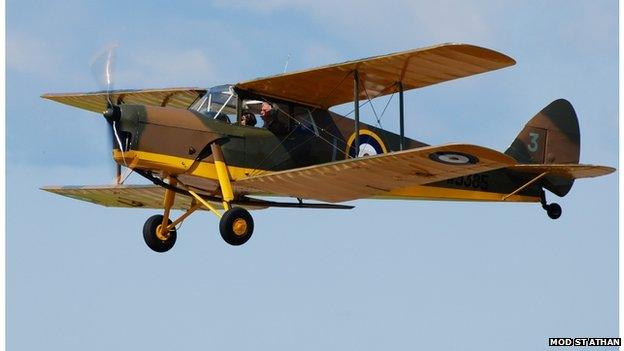St Athan return for World War II pilot training aircraft
- Published
Watch the aircraft arrive at St Athan and an interview with the pilot
The St Athan military base in the Vale of Glamorgan has celebrated its 75th anniversary with a special homecoming.
Newly-appointed commanding officer, Wing Commander Robert Balls, welcomed back one of the first planes which ever took off from there when the old air base opened in 1938.
The De Havilland Hornet Moth was a two-seater biplane whose design was already outdated even before the start of hostilities.
But as Brian Acott, St Athan's archivist and military historian explains, it nevertheless holds a special place in the hearts of everyone on the base.
"You could say the Hornet Moth and St Athan have a similar story in some ways," he said.
"Events and technology moved so quickly during the late 1930s and 40s that both were thought to have been obsolete before they'd seen action.
"St Athan was intended to have been a maintenance base beyond the reach of the Luftwaffe but the fall of France put paid to that, and the development of rapid monoplane fighters meant that the Hornet Moth was far too slow and vulnerable for combat duties.
"But 75 years on both are still going strong."
Once it had been rejected for air combat, the RAF's fleet of Hornet Moths were transferred to 32 Squadron, Maintenance Unit (32MU) and 4 Squadron, School of Technical Training (4TT).
Powered by a single 130 horsepower Gypsy engine and weighing roughly the same as a Ford Fiesta, it could cruise at around 80mph.
At St Athan they found new roles as submarine spotters, air taxis and even for helping to calibrate early radar installations.
'Flying continuously'
Their simplicity, stability and reliability also made them the ideal plane on which to train novice pilots and ground crew from St Athan.
A testament to their durability is that of around 160 built, somewhere between 25 and 30 are thought to still be in airworthy condition 75 years later.
W9385 G-ADND - still in her RAF livery - was flown into MoD St Athan by her current owner David Weston after an hour-long flight from Wiltshire.
"People say the design was outdated even then but it was always intended to be an easy-to-fly, easy-to-maintain workhorse, and it does it brilliantly," he said.
"I bought her from the Shuttleworth Collection in Bedfordshire in 1996 and, apart from a slight crash in 1971, she's been flying continuously all her life and could easily go for another 75 years if she's looked after properly.
"Once I learnt about her wartime history in St Athan I was thrilled to make her a part of their anniversary celebrations.
"I love the history behind vintage aeroplanes, as well as their mechanics and little idiosyncrasies but more than anything they're a joy to fly. She's not very fast, but feels like a machine not a computer."

The Hornet Moth was 'easy-to-fly, easy-to-maintain'
- Published9 July 2013
- Published18 July 2011